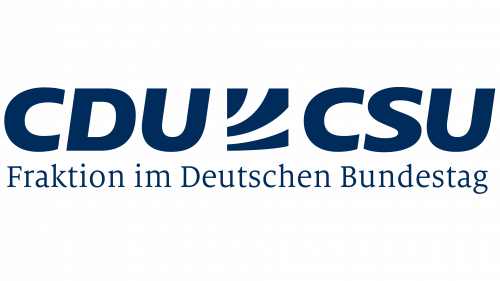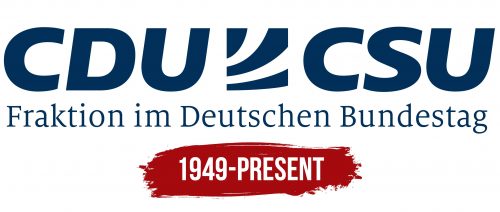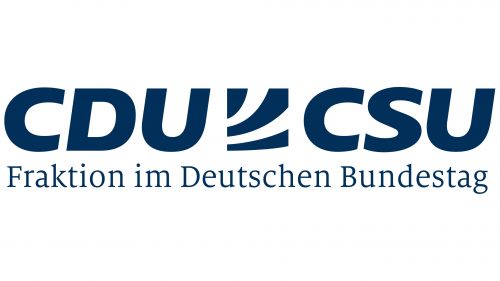The CDU/CSU logo demonstrates unity. It represents the merging of two political forces to form a strong bloc to integrate Christian values into modern German society.
CDU/CSU: Brand overview
In 1945, as the world grappled with the aftermath of World War II, a new political entity took shape in Germany: the Christian Democratic Union (CDU). Born from a fusion of Catholic and Protestant politicians, the party aimed to offer a Christian counterpoint to the prevailing ideologies of socialism and liberalism. Around the same time, the Christian Social Union (CSU) emerged as a regional conservative force in Bavaria, closely aligned with the CDU.
Konrad Adenauer, the CDU’s first Chancellor, assumed office in 1949. His tenure marked the beginning of West Germany’s reconstruction and integration into the Western bloc. A pivotal agreement in 1950 established that the CSU would operate solely in Bavaria while the CDU would represent the rest of Germany, forming a unified bloc at the federal level.
Under Adenauer’s leadership, the coalition dominated West German politics throughout the 1950s and early 1960s, championing policies rooted in the “social market economy.” Ludwig Erhard succeeded Adenauer in 1963, earning acclaim as the “father of the German economic miracle.”
From 1966 to 1969, the coalition entered a “grand coalition” with the Social Democrats (SPD) under Chancellor Kurt Georg Kiesinger. The 1969 elections ushered in an SPD and liberal Free Democrats (FDP) coalition, positioning the coalition in the opposition.
In 1982, the coalition reclaimed power with Helmut Kohl at the helm. Kohl’s chancellorship, lasting until 1998, became the longest in German history after Bismarck. Kohl’s tenure witnessed the historic reunification of Germany in 1990 and significant strides toward European integration, including the European Union’s founding and the euro’s introduction.
The 1998 election saw a defeat to an SPD and Green coalition, leading to Angela Merkel’s rise as the new CDU leader. Merkel’s ascendancy culminated in the 2005 elections, where the coalition triumphed, and she became Germany’s first female Chancellor, leading a “grand coalition” with the SPD. Merkel’s leadership extended through victories in the 2009, 2013, and 2017 federal elections, establishing her as a pivotal European figure, particularly during the 2008 financial crisis and the European debt crisis.
In 2015, Merkel’s decision to welcome hundreds of thousands of refugees sparked widespread debate and bolstered support for the right-wing Alternative for Germany (AfD). By 2018, Merkel announced her decision to step down as CDU chair and not seek another term as Chancellor, paving the way for Annegret Kramp-Karrenbauer to become her successor.
Kramp-Karrenbauer’s tenure faced setbacks, culminating in her resignation in 2021. Armin Laschet then stepped into the role of CDU leader. The coalition has consistently championed a social market economy, transatlantic partnership, European integration, and Christian values.
Meaning and History
What is CDU/CSU?
It is a political bloc in Germany consisting of two parties: the Christian Democratic Union (CDU) and the Christian Social Union (CSU). The bloc adheres to conservative and Christian-democratic views. Its main goals include economic development, strengthening the social market economy, and supporting family values and traditional institutions. The parties emphasize protecting citizens’ rights and freedoms, supporting small and medium-sized businesses, and Germany’s active participation in the European Union and international affairs.
1949 – today
During the creation of this logo, both parties, CDU and CSU, aimed to strengthen their positions in Germany’s political arena. The logo highlights their joint efforts and cooperation despite regional differences and underscores their goal of maintaining Christian and democratic values in German politics. The unification of the two parties in a single logo symbolizes their readiness to work together for the common good and prosperity of the country.
The CDU/CSU party logo consists of two abbreviations, united by a blue square with white lines. “CDU” stands for “Christlich Demokratische Union Deutschlands” (Christian Democratic Union of Germany), and “CSU” stands for “Christlich-Soziale Union in Bayern” (Christian Social Union in Bavaria).
The two white lines on the blue square symbolize the two political forces that exist separately but work in the same field and operate harmoniously. These lines represent the unity of Christian values, purity, honesty, and justice, which allows the parties to find common ground and demonstrate to other political forces how to work together for Germany’s prosperity.
The logo reflects the importance of unity and cooperation between the two parties despite their regional differences. It emphasizes their common pursuit of stability, moral and Christian values, and the creation of a just society.
The logo’s font is simple and modern, giving it clarity and readability. It symbolizes reliability and accessibility, highlighting the parties’ professionalism and organization.
The logo’s blue color is associated with conservatism, calmness, and balance. The white lines symbolize purity and honesty, reflecting the parties’ core values.





